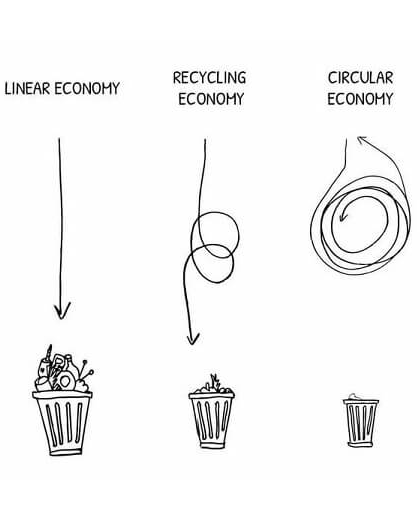go circular.
Repair, re-use, re-sell, remake, repeat.
What exactly is the circular economy?
First, we need to take a look at the current economic models we originally based our designs, products and systems.
linear and recycling economies.
The linear economy essentially is based on a ‘take-make-dispose’ model whereby each product has one use then it goes straight to the bin.
We take the raw materials, we make them into a product for distribution to the end-user who buys it, uses it until it is then accumulated as waste. This is, of course, not a sustainable model, and is one that our planet with finite resources cannot uphold.
The recycling economy begins at the end of this, the ‘get rid’ stage of the product's lifecycle. It aims to reduce pollution and conserve natural resources by a means of recycling, where waste is systematically collected, processed and re-used.
In order for recyclability to happen, it has to be thought about at the design stage, where the concept should include how the product can be re-used in a sustainable way after its initial use.
The circular economy, however, takes this a step further and during the concept design stage, it works to prevent waste and pollution from being created in the first place.
the circular economy
In simple terms, it’s the way we produce and use goods and services. A circular model redefines the economy and principles of designing out waste and pollution to keep products and materials in use for as long as possible.
For furniture, this means :
- Reusing products where possible at end of life by refurbishing, repairing or re-purposing (check out our Regener8 scheme).
- Redesigning the product to eliminate or reduce the number of raw materials at the beginning of life (e.g. using recycled fabrics, plastics or metals to make the product).
- Recycling individual materials where possible at end of life.

“In a properly built circular economy, one should rather focus on avoiding the recycling stage at all costs. It may sound straightforward but preventing waste from being created in the first place is the only realistic strategy.”
World Economic Forum
The circular economy challenges us to think about recycling and waste as design flaws and think about the continuity of the product.
repair. reuse. resell. remanufacture. & repeat.
get in touch.
Please complete the form or call us on 01560 329 916 to discuss how Saxen can enhance your spaces.
Contact Us
Thank you for contacting us.
We will get back to you as soon as possible.
Oops, there was an error sending your message.
Please try again later.
stay informed.
We promise to only send you the good stuff. No spam.
We will get back to you as soon as possible
Please try again later
